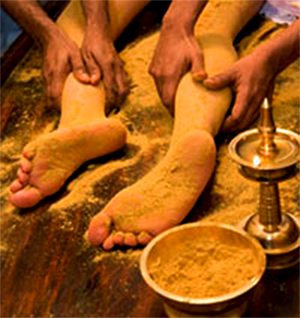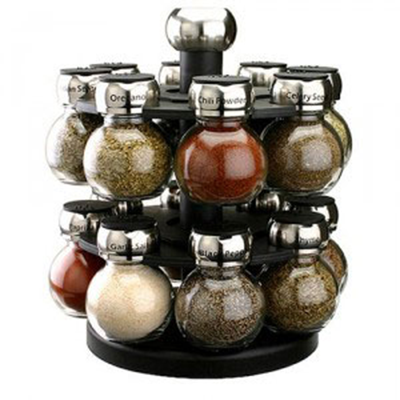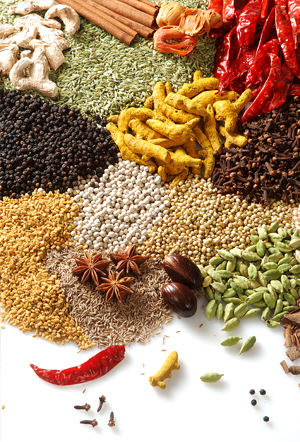Magic of Spices
Imagine your food without any spices. Unimaginable, is it?
Right from the kitchen and medicinal uses in homes, spices have an important role to play in different places. India is blessed with a varied climate and each of its state produces some spice or the other. No wonder why spices are used so extensively for cooking in India. Now not only in India but also in most of the other countries spices are considered to be of great use.
Apart from adding colour, flavour and taste, consumption of spices provides infinite health benefits. One can be more creative in use of spices if you know its uses better. Some may be a substitute for your costly beauty products and or even medicines.

Find below quick overview of Indian spices, their uses and benefits
Spices |
Uses |
Benefits |
| Asafoetida (Hing) | It is used for seasoning food especially snacks and has medicinal uses. | A good remedy for whooping cough and stomach ache caused due to gas. |
| Bay leaf (Tez Patta) | It is used in cooking to add a specific flavour to food It also has some medicinal properties. | Bay leaf oil possesses antifungal and anti bacterial |
| Cardamom (Elaichi) | It is used in most of the Indian and other sweet dishes to give a good flavour and smell. It is also used widely in pharmaceutical sector. | Helps to control bad breath and digestive disorder. A whole cardamom chewed is good for coping with diabetes. |
| Chilli (Lal Mirch) | It is a main ingredient used for adding hot flavour to the food. Dry chilly is extensively used as spice in curried dishes. It is also used as an ingredient in curry powder and in seasonings. Bird chilly is used in making hot sauces as pepper sauce and Tabasco sauce. This food is very low in Cholesterol and Sodium. It is also a good source of Vitamin C and Magnesium, and a very good source of Dietary Fiber, Vitamin B6, Iron, Potassium and Manganese. |
The antioxidants present in chilli help to cope with cholesterol. It also helps burning calories. A simple ointment made by mixing ground chili peppers in a standard vitamin E cream can be used to stimulate blood flow to an area affected by arthritic pain, lumbago, rheumatism or neuralgia, but again it should be stressed that it is a mask for pain and not always a cure. Capsicum has a tonic and carminative action; and used in Ayurvedic medicine to promote digestion and to soothe a sore throat. When grounded with coriander seeds and ginger, it soothes abdominal pain and nausea. |
| Cinnamon (Dalchini) | It is used for mainly for seasoning food and preparing masalas It has medicinal uses too. | It supports natural production of insulin and reduces blood cholesterol |
| Clove (Laung) | It is used as a cooking ingredient mainly for seasoning or preparing Masalas. | Clove oil is beneficial for coping with tooth ache and sore gums. It is also beneficial remedy for chest pains, fever, digestive problems, cough and cold. |
| Coriander (Dhaniya) | Coriander leaves as well as seeds are used in cooking. It also has some medicinal uses. It sweetens the breath, especially after eating garlic. As a medicinal plant, coriander has been used as an antispasmodic, carminative, stimulant, and stomachic. Coriander has also exhibited hypoglycemic activity. |
It can be used externally on aching joints and rheumatism. It is also good for coping with soar throat, allergies, digestion problems, hay fever etc. In Ayurvedic medicine, it is used to treat nosebleeds, coughs, hemorrhoids, scrofulous, painful micturation, edema, bladder complaints, vomiting, amoebic dysentery, and dizziness. The seeds can be made into poultices, lotions, or salves for external use to prevent infection of wounds and to ease muscle and joint aches. Coriander seed oil has antibacterial properties and is used for treating colic, neuralgia and rheumatism. The oil also counteracts unpleasant odours in pharmaceutical preparations and tobacco. It is used in perfumes, liqueurs and gin |
| Cumin (Zeera) | It is used for cooking and it also possesses medicinal properties. Oil of cumin is used as fragrances in perfume. The cumin seed is extensively used in mixed spices and for flavoring curries, soups, sausages, bread and cakes. It is an ingredient of curry powder, pickles and chutneys. |
It is a good source of iron and keeps immune system healthy. Water boiled with cumin seeds is good for coping with dysentery. As a medicinal plant, Cumin has been utilized as stomachic, diuretic, carminative, stimulant, astringent, emmenagogic and antispasmodic. Cumin is valuable in dyspepsia diarrhea and hoarseness, and may relieve flatulence and colic. It is supposed to increase lactation and reduce nausea in pregnancy. Used in a poultice, cumin relieves swelling of the breast or the testicles. Smoke in a pipe with ghee, it is taken to relieve the hiccups |
| Curry leaves(Curry Patta) | It is used as a main ingredient for seasoning in some countries. It has many medicinal uses. | These leaves are beneficial for reducing blood sugar. Each part of the plant provides some benefit or the other. The dried leaves are extensively used in herbal medicines. |
| Fenugreek (Methi) | It is mainly used as a green leafy vegetable and seeds are used for seasoning and preparing Masalas. It also has medicinal uses. Fenugreek seeds help lower blood sugar and reduce the need for insulin. It may also improve glucose tolerance and excretion. Fenugreek may also have beneficial effects on triglycerides. | Fenugreek seed tea or sweet fudge is good for increasing breast milk. It also helpful for treating diabetes and lowering cholesterol. Fenugreek and Digestive Aid - Fenugreek is used medicinally as a digestive aid . Fenugreek in Anemia - It is useful in low blood pressure and anemia because of its high iron content. Fenugreek Breastfeeding Benefits - The benefits of Organic fenugreek in breastfeeding stem from the diosgenin in its seeds, a compound similar to estrogen. As such it increases milk production and stimulates breast tissue growth in human as well as in cows. Fenugreek and Cholesterol - The benefits of fenugreek may inhibit the absorption of cholesterol as well as decrease the amount of cholesterol |
| Garlic (Lassan) | It is used for cooking as well as for the medicinal purpose. Garlic is a natural immune system enhancer. The active properties, sulphur compound allicin, ajoene, allyl sulfides and vinyldithins, has been shown to kill 23 types of bacteria, including salmonella and staphylococcus. It can also kill 60 types of fungi and yeast. | It is useful for coping with cough and cold. It also has antibiotic properties. Garlic enhances the body's immunity from colds and flu. Garlic has been proven effective in lowering blood pressure. The active ingredient allicin is effective in helping to promote proper circulation throughout the body. Garlic can drop the level of cholesterol in the blood by 15% when taken for 2 months or more. When Garlic is taken as a supplement and combined with a positive diet change, blood cholesterol levels can drop enough to reduce heart attack risk by 30%. Garlic can be safely taken for mild, recurring or chronic infections such as infections of the mouth, ears, throat, and colds. Other benefits to using Garlic are stress reduction, blood purification, and anticoagulant effects. |
| Ginger (Adrak) | It is used for giving a specific flavour to food and has many medicinal uses. Supports healthy digestion, offering 180 times the protein digestive power of papaya. Contains at least 12 anti-aging constituents that inactivate free radicals. | Soothes digestion. Supports blood platelet health and cardiovascular function. Reduces inflammation. Enhances natural resistance for cold and flu. It is used for abdominal bloating, coughing, vomiting, diarrhea, and for the treatment of inflammatory joint diseases, such as arthritis and rheumatism. |
| Mustard (Rye) | It is used for seasoning as well as green leafy vegetable. The use of mustard oil is extensive in India but it is banned in some countries. | Mustard oil is good for body massage and even for getting good hair. It consists of omega-3 fatty acids. It is an excellent source of iron, zinc, manganese, calcium, protein etc. |
| Nutmeg (Jaiphal) | It is used in powdered form for garnishing and also for masala preparation. It is used in soaps, perfumes and shampoos. It can also be used for medicinal purpose. | It is beneficial for the treatments of asthma, heart disorder and bad breath. |
| Pepper (Kaali Mirch) | It is extensively used in cooking, especially for garnishing. It is has many medicinal uses too. | It helps coping with cold, cough, infections etc. It helps to deal with muscle pains and digestive problems. Black Pepper has been used as carminative, reducing stomach and intestinal gas and has been found to stimulate the activities of the heart and kidneys. The Pepper fruits are acrid, bitter, carminative, aphrodisiac, diuretic, digestive and stimulant hence useful for arthritis, asthma, fever, cough, dysentery, dyspepsia and flatulence. Also used in vertigo, paralytic and arthritic disorders. |
| Saffron (Zaffran/Kesar) | It is used for cooking as well as in beauty products. It is mainly used in sweet dishes. It has good medicinal properties. | It helps to cope with skin diseases. It is a good remedy for cough, cold and asthma. |
| Star anise (Chakra Phool) | It is used in cooking and for medicinal purpose | Star anise oil is beneficial for rheumatism. It is helpful for digestion and avoiding bad breath |
| Turmeric (Haldi) | It is used in cooking and skin care products. It has wide range medicinal uses. Turmeric is anti-viral, anti-bacterial, anti-fungal, anti-parasitic and anti-biotic. Turmeric keeps viruses from replicating. It kills staphylococcus and salmonella | It strengthens the digestive system, aids in the digestion of protein and normalizes metabolism. Turmeric is a blood purifier. It regulates blood sugar. It corrects anemia and restores poor circulation. Turmeric removes oxidized cholesterol - Preventing heart attack! Turmeric is also an anti-inflammatory. Turmeric helps keep your tendons, ligaments and joints moist, flexible and strong. Taken internally, it will help reduce pain and swelling from an injury or sprain. |
Though these spices provide innumerable benefits they should be used sparingly. The excessive use of spices in food can cause harm to the health. Try to make specific use of these spices. This will help you to make optimal use of the resources provided by nature. Strike the right balance and add some spice to your life.
Extraordinary uses of Spices
"Your spice cabinet is full of problem solvers -- check out few different ways to use spices"
• Make a spiced up hair tonicYou can spice up your hair care regimen with a homemade tonic that will enhance your natural color and impart shine. For dark hair, use 1 tablespoon crumbled sage or 1 sprig chopped fresh rosemary or a mixture of 1 teaspoon allspice, 1 teaspoon ground cinnamon, and 1/2 teaspoon ground cloves. For blond hair, use 1-tablespoon chamomile. Pour 1-cup boiling water over the herb or spice mix, let it steep for 30 minutes, strain it through a coffee filter, and let it cool. Pour it repeatedly over your hair (use a dishpan to catch the runoff) as a final rinse after shampooing.

If you nick your finger while chopping vegetables, you may not even need to leave the kitchen for first aid. Alum, the old-fashioned pickling salt at the back of your spice cupboard, is an astringent. In a pinch, sprinkle some on a minor cut to stop the flow of blood.
• Keep feet smelling sweet
If you use sage or bay leaf only to stuff meat, then you've been missing out. Bayleaf & Sage is great for preventing foot odor because it kills the odor-causing bacteria that grow on your feet in the warm, moist environment inside your shoes. Just crumble a leaf or two into your shoes before you put them on. At the end of the day, just shake the remains into the trash.
•Deodorize bottles for reuse
You'd like to reuse those wonderful wide-mouthed pickle jars, but simply washing them with soap and water doesn't get rid of the pickle smell. What to do? Add 1 teaspoon dry mustard to 1 quart (1 liter) water, fill the jar, and let it soak overnight. It'll smell fresh by morning. This solution banishes the odor of tomatoes, garlic, and other foods with strong scents.
•Keep your thermos fresh
You just uncapped the thermos bottle you haven't used for six months, and the inside smells musty. To keep it from happening the next time, place a whole clove inside the thermos before capping it. A teaspoon of salt works too. Be sure to empty and rinse the thermos before using it.
• Scent your home
What could be more welcoming than the smell of something good cooking ! Instead of using commercial air fresheners, simply toss a handful of whole cloves or a cinnamon stick in a pot of water and keep it simmering on the stove for half an hour. Or place a teaspoon or two of the ground spices on a cookie sheet and place it in a 200°F (93°C) oven with the door ajar for 30 minutes. Either way, your house will naturally smell spicy good.
•Keep woolens whole
Woolen clothing can last a lifetime -- if you keep moths away. If you don't have a cedar-lined chest or closet, preserve your cold-weather clothing using clove sachets. Fill muslin bags with a handful of whole cloves. To prevent any transfer of oils or color to clothes and to contain any spills, put the sachet in a small plastic bag, but don't seal it. Attach it to a hanger in your closet or tuck one in your sweater chest for woolens without holes.
•Keep ants at bay
Flour, sugar, and paprika can all fall prey to ants. Keep these cooking essentials safe by slipping a bay leaf inside your storage containers. If you're concerned about the flour or sugar picking up a bay leaf flavor, tape the leaf to the inside of the canister lid.
•Stamp out silverfish
These pesky critters frequent places with lots of moisture, such as kitchens, baths, and laundry rooms. Hang an aromatic sachet containing apple pie spices, sage, or bay leaves on a hook in your bathroom vanity and behind the washer, or keep a few in decorative baskets along baseboards.
•Control insects in the garden
You don't have to use harsh pesticides to control small-insect infestation outdoors. If ants are swarming on your garden path, add 1 tablespoon ground black pepper (or another strong-smelling ground spice, such as ground cloves or dry mustard) to 1 cup sifted white flour and sprinkle the mixture on and around the pests. They'll vanish within the hour. Sweep the dry mix into the garden or yard instead of trying to hose it off; water will just make it gooey.
•Deter plant-eating animals
Everyone knows that hot peppers make your mouth burn. So if rodents are attacking your ornamental plants, the solution may be to make them too "hot" for the critters. In fact, hot peppers are the basis for many commercial rodent repellents. Chop up the hottest pepper you can find and combine it with 1 tablespoon ground cayenne pepper and 2 liters water. Boil the mix for 15-20 minutes, then let it cool. Strain it through cheesecloth, add 1 tablespoon dishwashing liquid, and pour it into a spray bottle. Spray vulnerable plants liberally every five days or so. The spray works best for rabbits, chipmunks, and woodchucks, but may also deter deer, especially if used in combination with commercial products.
•Shield your vegetable garden
Aromatic plants such as basil, tansy, marigolds, and sage are all reputed to send a signal to bugs to go elsewhere, so try planting some near your prized vegetables. Mint, thyme, dill, and sage are old-time favorites near cabbage family plants (cabbage, broccoli, cauliflower, and brussels sprouts) for their supposed ability to fend off cabbage moths. Best of all, you can eat the savory herbs!
Proper Storage & Handling of Spices
Nature gives spices a remarkably protective cell structure. Whole spices, dried and stored, have been known to keep for many years and then deliver potent flavor when ground. Ground spices and herbs are more fragile, but when stored (cool, dry), they have a "life" adequate for any normal manufacturing and foodservice service kitchen needs (from six months to a year if necessary). The customer, however, should’t test their limits.Here are some basic rules on storing and handling spices that will help protect your investments: 1. Keep away from heat...At the very least, they need to be kept cool and dry ….. never near a smokehouse or kitchen range or other source of high heat; never in a wash-down area or by the dishwasher or other place where the containers are apt to get wet or humidity gets high. In large-scale storage, the containers should always by palletized and kept away from outside walls. 2. Keep it cool and dry...Cool means no higher that 68 F (20 C) and dry is no higher than 60% relative humidity. 3. Cold storage is recommended...If possible, cold storage (32 F to 45 F) is highly recommended, particularly for the capsicums (paprika, red pepper, etc.) and spices where volatile oil and/or characteristic odors are important quality attributes (i.e. allspice, cloves, dill, parsley flakes, etc.). At 70 to 80 F, paprika will lose about 1% of its color every 10 days. At higher temperatures, losses are even more rapid. In cold storage, however, paprika’s color loss is reduced to ½% every 10 days and therefore, it can be held satisfactorily for up to 6 months. Cold storage also protects against infestation and rancidity in the fixed oils (of such items as sesame and poppy seeds).

Important flavour compounds in spices
Spices were once valued exclusively for their aroma and flavour. Flavour still constitute the major attraction for spices.| Spice | Important flavour compounds | |
| Allspice | : | Eugenol,ß<-caryophyllene |
| Anise | : | (E)-anethole, methyl chavicol |
| Black pepper | : | Piperine,S-3-Carene, ß-caryophyllene |
| Caraway | : | d-carvone,carone derivatives |
| Cardamom | : | a-terpinyl acetate, 1-8-cineole, linalool |
| Cinnamon, cassia | : | Cinnamaldehyde,eugenol |
| Chilli | : | Capsaicin,dihydro capsaicin |
| Clove | : | Eugenol, eugeneyl acetate |
| Coriander | : | d-linalool, C10-C14-2-alkenals |
| Cumin | : | Cuminaldehyde, p-l,3-mentha-dienal |
| Dill | : | d-carvone |
| Fennel | : | (E)-anethole, fenchone |
| Ginger | : | Gingerol,Shogaol, neral,geranial |
| Mace | : | a-pinene,sabinene, 1-terpenin-4-ol. |
| Mustard | : | Ally isothiocynate |
| Nutmeg | : | Sabinine,a-pinene, myristicin |
| Parsley | : | Apiol |
| Saffron | : | Safranol |
| Turmeric | : | Turmerone,Zingeberene, 1,8-cineole |
| Bay laurel | : | 1,8-cineole |
| Oregano | : | Carvacrol,thymol |
| Rosemary | : | Verbenone,1-8-cineole, camphor, linanool |
| Thyme | : | Thymol, carvacrol |
| Peppermint | : | 1-menthol, menthone,menthfuran |

